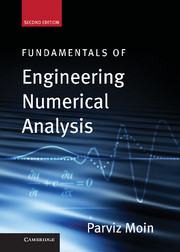Book contents
- Frontmatter
- Contents
- Dedication
- Preface to the Second Edition
- Preface to the First Edition
- 1 INTERPOLATION
- 2 NUMERICAL DIFFERENTIATION – FINITE DIFFERENCES
- 3 NUMERICAL INTEGRATION
- 4 NUMERICAL SOLUTION OF ORDINARY DIFFERENTIAL EQUATIONS
- 5 NUMERICAL SOLUTION OF PARTIAL DIFFERENTIAL EQUATIONS
- 6 DISCRETE TRANSFORM METHODS
- A A REVIEW OF LINEAR ALGEBRA
- Index
- References
5 - NUMERICAL SOLUTION OF PARTIAL DIFFERENTIAL EQUATIONS
Published online by Cambridge University Press: 05 June 2012
- Frontmatter
- Contents
- Dedication
- Preface to the Second Edition
- Preface to the First Edition
- 1 INTERPOLATION
- 2 NUMERICAL DIFFERENTIATION – FINITE DIFFERENCES
- 3 NUMERICAL INTEGRATION
- 4 NUMERICAL SOLUTION OF ORDINARY DIFFERENTIAL EQUATIONS
- 5 NUMERICAL SOLUTION OF PARTIAL DIFFERENTIAL EQUATIONS
- 6 DISCRETE TRANSFORM METHODS
- A A REVIEW OF LINEAR ALGEBRA
- Index
- References
Summary
Most physical phenomena and processes encountered in engineering problems are governed by partial differential equations, PDEs. Disciplines that use partial differential equations to describe the phenomena of interest include fluid mechanics, where one is interested in predicting the flow of gases and liquids around objects such as cars and airplanes, flow in long distance pipelines, blood flow, ocean currents, atmospheric dynamics, air pollution, underground dispersion of contaminants, plasma reactors for semiconductor equipments, and flow in gas turbine and internal combustion engines. In solid mechanics, problems encountered in vibrations, elasticity, plasticity, fracture mechanics, and structure loadings are governed by partial differential equations. The propagation of acoustic and electromagnetic waves, and problems in heat and mass transfer are also governed by partial differential equations.
Numerical simulation of partial differential equations is far more demanding than that of ordinary differential equations. Also the diversity of types of partial differential equations precludes the availability of general purpose “canned” computer programs for their solutions. Although commercial codes are available in different disciplines, the user must be aware of the workings of these codes and/or perform some complementary computer programming and have a basic understanding of the numerical issues involved. However, with the advent of faster computers, numerical simulation of physical phenomena is becoming more practical and more common. Computational prototyping is becoming a significant part of the design process for engineering systems. With ever increasing computer performance the outlook is even brighter, and computer simulations are expected to replace expensive physical testing of design prototypes.
Information
- Type
- Chapter
- Information
- Fundamentals of Engineering Numerical Analysis , pp. 101 - 166Publisher: Cambridge University PressPrint publication year: 2010
